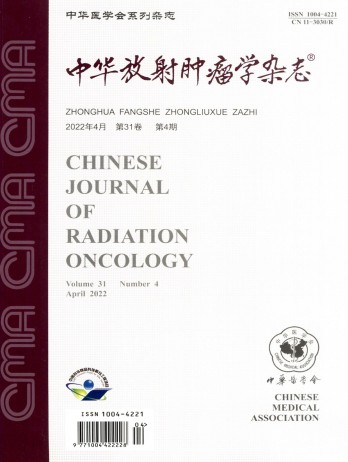Study of the mechanism of anti-tumor effect of Metformin-enhanced radiotherapy in CT26WT cell lines or mouse models with transplanted tumors
引用次数: 0
Abstract
Objective To investigate the inhibitory effect and mechanism of Metformin (Met) combined with irradiation in CT26WT cell lines or mouse models with transplanted tumors. Methods CT26WT cell line was treated with 0.5μmol/L, 1.0μmol/L, 5.0μmol/L and 10.0μmol/L Met, and CellTiter Glo kit was used to detect the inhibitory effect of Met at different concentrations on the viability of CT26WT cells. CT26WT cell line was treated with the control, Met (10μmol/L), 15Gy irradiation and 15Gy irradiation+ Met (10μmol/L). Clone formation assay was employed to detect the cell proliferation activity. Bablc mouse models of transplanted tumors (tumor size>150 mm3) were established and randomly divided into the control, 15Gy irradiation, Met and 15Gy irradiation+ Met groups. Mice were given with 750 mg/kg Met at 24 h before irradiation. Transplanted tumor volume was measured regularly to delineate the growth curve of transplanted tumors and survival curve. The expression levels of P-H2AX and Sting proteins in CT26WT cells and transplanted tumors were detected by Western blot. The infiltration of CD8a (+ ) T cells in transplanted tumor tissues was detected by immunohistochemistry. Results The relative cell survival rate was 100%, 87.9%, 87.8%, 87.3% and 76.5% in the 0, 0.5, 1.0, 5.0 and 10.0μmol/L Met groups, respectively (all P<0.05). The inhibitory effect of 10.0μmol/L was significantly stronger than that of 5.0μmol/L (P<0.001). The colone formation rate 34.0%, 24.0%, 22.3% and 14.0% in the control, Met, 15Gy irradiation, Met+ 15Gy irradiation groups, respectively (all P<0.001). Western blot showed that compared with the control group, the expression of Sting protein was increased by 2.99-fold after Met treatment (P<0.001), and increased by 1.37-fold and 4.41-fold in the 15Gy irradiation and 15Gy irradiation+ Met groups (both P<0.01). Compared with the 15Gy irradiation group, the expression of P-H2AX protein was significantly increased by 1.43 times after treatment with 15Gy+ Met (P<0.001). The transplanted tumor growth curve showed that the transplanted tumor growth in the 15Gy+ Met group was slower than that in the control group[(1007.0±388.5) mm3vs. (2639.0±242.9) mm3, P<0.05)]. The overall survival time in the 15Gy irradiation+ Met group was 48 d, significantly longer than 32 d in the control group (P<0.001). Compared with the control group, the expression of P-H2AX and Sting proteins in the 15Gy+ Met group was increased by 8.8-fold and 1.6-fold (both P<0.001). Immunohistochemical staining showed that the infiltration of CD8a (+ ) T cells in the 15Gy irradiation+ Met group was significantly higher than that in the control group (P<0.01). Conclusions Met combined with radiotherapy can inhibit the proliferation and clone formation of colon cancer cells, probably by aggravating DNA damage and activating the Sting signaling pathway, eventually leading to the increase of CD8a (+ ) T cells in tumor tissues and enhancing the killing effect upon transplanted tumor cells. Key words: Metformin; Sting gene; H2AX gene; CT26WT cell line; Transplanted tumor/Bablc mouse二甲双胍增强放疗对CT26WT细胞系或移植瘤小鼠模型抗肿瘤作用机制的研究
目的探讨二甲双胍(Met)联合放疗对CT26WT细胞株或移植瘤小鼠模型的抑制作用及其机制。方法分别用0.5μmol/L、1.0μmol/L、5.0μmol/L和10.0μmol/L的Met处理CT26WT细胞,用CellTiter-Glo试剂盒检测不同浓度Met对CT26WT生存能力的抑制作用。用对照组、Met(10μmol/L)、15Gy照射和15Gy+Met(10%μmol/L)处理CT26WT细胞。采用克隆形成法检测细胞增殖活性。建立移植肿瘤(肿瘤大小>150mm3)的Bablc小鼠模型,并随机分为对照组、15Gy照射组、Met组和15Gy辐照+Met组。在照射前24小时给予小鼠750mg/kg Met。定期测量移植瘤体积,绘制移植瘤生长曲线和生存曲线。Western blot检测P-H2AX和Sting蛋白在CT26WT细胞和移植瘤中的表达水平。免疫组化检测CD8a(+)T细胞在移植瘤组织中的浸润。结果0、0.5、1.0、5.0和10.0μmol/L Met组的相对细胞存活率分别为100%、87.9%、87.8%、87.3%和76.5%(均P<0.05)。10.0μmol/L的抑制作用明显强于5.0μmol/L(P<0.001)。对照组、Met、15Gy、Met+15Gy组的结肠形成率分别为34.0%、24.0%、22.3%和14.0%,Western blot显示,与对照组相比,Met处理后Sting蛋白的表达增加了2.99倍(P<0.001),15Gy和15Gy+Met组分别增加了1.37倍和4.41倍(均P<0.01),移植瘤生长曲线显示,15Gy+Met组移植瘤生长缓慢[(1007.0±388.5)mm3 vs(2639.0±242.9)mm3,P<0.05)],与对照组相比,P-H2AX和Sting蛋白在15Gy+Met组的表达分别增加了8.8倍和1.6倍(均P<0.001)。免疫组化染色显示,15Gy+Met组CD8a(+)T细胞浸润明显高于对照组(P<0.01)癌症细胞的杀伤作用,可能是通过加重DNA损伤和激活Sting信号通路,最终导致肿瘤组织中CD8a(+)T细胞的增加,并增强对移植肿瘤细胞的杀伤效果。关键词:二甲双胍;Sting基因;H2AX基因;CT26WT细胞系;移植瘤/Bablc小鼠
本文章由计算机程序翻译,如有差异,请以英文原文为准。
求助全文
约1分钟内获得全文
求助全文
来源期刊
自引率
0.00%
发文量
6375
期刊介绍:
The Chinese Journal of Radiation Oncology is a national academic journal sponsored by the Chinese Medical Association. It was founded in 1992 and the title was written by Chen Minzhang, the former Minister of Health. Its predecessor was the Chinese Journal of Radiation Oncology, which was founded in 1987. The journal is an authoritative journal in the field of radiation oncology in my country. It focuses on clinical tumor radiotherapy, tumor radiation physics, tumor radiation biology, and thermal therapy. Its main readers are middle and senior clinical doctors and scientific researchers. It is now a monthly journal with a large 16-page format and 80 pages of text. For many years, it has adhered to the principle of combining theory with practice and combining improvement with popularization. It now has columns such as monographs, head and neck tumors (monographs), chest tumors (monographs), abdominal tumors (monographs), physics, technology, biology (monographs), reviews, and investigations and research.

 求助内容:
求助内容: 应助结果提醒方式:
应助结果提醒方式:


